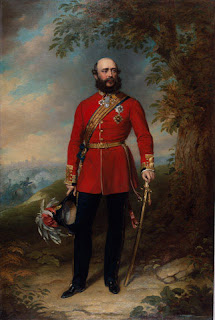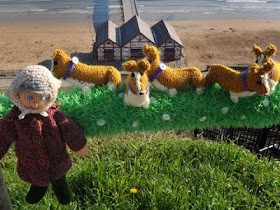Robert Brindle was born in Liverpool 4 November 1837 and studied at the
English College in Lisbon. He was ordained into the Roman Catholic priesthood in 1862, serving the Diocese of Plymouth, before becoming a chaplain to the forces in 1874. He was stationed at Woolwich, Aldershot and at Halifax, Nova Scotia.
Egypt, 1882-1885: the Urabi Revolt and The Gordon Relief Expedition
In 1882 he accompanied the Expeditionary Force to Egypt to quell the
Urabi Revolt, and served there and in
the Sudan with the Royal Irish Regiment for the next four years, exercising
'over his flock a combination of the spiritual influence of the Pope and the
earthly authority of a Regimental Sergeant-Major'. He missed
the battle of Tel-el-Kebir due to cholera staying in Cairo, where he nursed those suffering in an outbreak of enteric fever.
During the unsuccessful
Gordon Relief Expedition of 1884-85 Brindle immediately made a favorable impression on the
Commander-in-Chief,
Lord Wolseley. Wolseley had put up a prize
of £10 for the Regiment making the best time in negotiating the river.
Sir Evelyn Wood later recalled:
I was riding up the banks of the Nile on a camel, and [Brindle] was pulling in a boat of the Royal Irish Regiment. About sundown on Christmas Day I saw a little flotilla of boats flying the Royal Irish flag toiling up the river. Father Brindle got out when he had pulled up to us, hot, tired and irritable, with his hands blistered and perspiration running down his face. Said I: 'Father, what have you been doing?' 'Pulling stroke in order to encourage them.' 'Any result?' I asked. 'Devil a bit.' .... The Father was, however, unduly pessimistic, for the Royal Irish won Lord Wolseley's prize.'
During the withdrawal of the Expedition the Royal Irish
were ordered across the Bayuda Desert, and Wolseley decided that to send the
Regiment without its firebrand Padre was to reduce its rate of march and general
fighting efficiency. Accordingly Father Brindle was supplied with a camel for
the 100 mile march, but in the event he made the whole journey on foot. He
further borrowed a horse and, though harassed by skirmishers, helped the
stragglers by allowing them to ride until they were sufficiently recovered to
continue marching - 'Those of his flock whom he suspected of swinging the lead
were threatened with ex-communication if they failed to keep going'. The Royal
Irish completed the return journey in just 67 hours by which time the soles of
Father Brindle's boots were gone and rags rolled about his feet, had replaced
them. After participation in the Battle of Ginnis in December 1885, Father
Brindle returned to England.
 |
| Field Marshall Lord Wolseley (1833-1913), Brindle's admirer |
For many years
Bishop Brindle's photograph stood on the mantlepiece of Wolseley's office in
London. One day a stranger noticed the portrait and asked the Field-Marshal who
it was. He replied, 'That is one of the finest soldiers in the British Army,
Father Brindle'.
The Dongola and Nile Expeditions, 1897-1899
Brindle served as Chaplain at Colchester and
Aldershot for a further ten years. In 1896, aged 59 years, he sailed once more for
Egypt and was attached to
Sir Herbert Kitchener's Expedition at Dongola. During the long
period of inaction that ensued, Father Brindle proved instrumental in keeping
the men on the straight and narrow - 'The men', he reassured Lord Edward Cecil
of the Grenadiers, 'will do anything if they are going to have a good fight
later on'. When typhoid, dysentery and illness brought on by poor sanitation,
bad water and the heat, took hold, it was Father Brindle who did as much as
anyone to care for the sick of the rank and file. The war artist
Richard Caton-Woodville recalled, 'It
was he who carried the Tommies out of their quarters in his arms, placed them in
the ambulance to convey them to hospital when nobody else would come near, as
the cholera was raging and the men were dying like flies, and even many of the
Doctors themselves had died'.
In March 1898, during Kitchener's halt at Atbara,
Caton-Woodville witnessed another heroic deed:
It was a Saturday night,
and word came from another camp some nine miles away that a Catholic soldier was
dying. Unarmed, Father Brindle set out at once and walked across the El-Teb,
which was infested by the enemy. He administered the last rites to the dying
man, and stayed with him to the end. He then tramped back without rest or food,
and reached the camp in time to say Mass for his men on Sunday
morning
Brindle was subsequently present in the fighting line at the
Battles of
Atbara and
Omdurman which saw the defeat of the Mahdist forces and the avenging of Gordon.
He was awarded the Distinguished Service Order 'in recognition of services in Egypt and the Sudan, including the battles of Atbara and Khartoum' (London Gazette, 15 November 1898), which was presented by Kitchener at a full dress parade of the
Cairo Garrison,
The Gordon Memorial Service
 |
| Brindle and the other chaplains officiating at the Gordon memorial service |
Following the entry into Khartoum, Kitchener decided to hold a memorial service for General Gordon among the
ruins of the Governor-General's Palace.
The service was conducted by four chaplains attached to the British infantry:
Presbyterian, Church of England, Wesleyan and Roman Catholic. Kitchener stood
with his staff while behind him stood the Headquarters staff and generals of
divisions; on either side of him were representative detachments of the Egyptian
army, detachments of General Gatacre’s division and a small corps of officers
from the Royal Engineers, Gordon’s own corps.
According to GW Steevens,
amidst a silence
broken only by the guns, the four chaplains,Catholic,
Anglican, Presbyterian, and Methodist, came slowly forward and ranged
themselves, with their backs to the palace, just before the Sirdar. The
Presbyterian read the Fifteenth Psalm. The Anglican led the rustling whisper of
the Lord's Prayer. Snow-haired Father Brindle, best beloved of priests, laid his
helmet at his feet, and read a memorial prayer bareheaded in the sun. Then came
forward the pipers and wailed a dirge, while Sudanese played Abide With Me.
Perhaps lips did twitch just a little to see the ebony heathens
fervently blowing out Gordon's favourite hymn; but the most irresistible
incongruity would hardly have made us laugh at this moment. And there were those
who said the cold Sirdar himself could hardly speak or see, as General Hunter
and the rest stepped out according to their rank and shook his hand. What
wonder? He has trodden this road to Khartoum for fourteen years, and he stood at
the goal at last.
Initially, the Church of England padre, the Revd AWB Watson, objected to
the participation of his colleagues on the grounds that, as Gordon was a member
of the Church of England, their involvement would be both inappropriate and
irrelevant. He probably had a point, as Gordon was violently and eccentrically Protestant. Kitchener would have none of it.
Striking an early blow for ecumenicalism, he told Watson that he had the choice
of conducting a joint service with all his fellow clergy or of catching the next
steamer back to Cairo. The service, in common with everything else which
happened in the Sudan for some time to come, was duly held in accordance with
the Sirdar's wishes.
Episcopate
In 1898 Brindle retired from the
Army and was appointed an auxiliary bishop for the Archdiocese of Westminster. He was consecrated titular bishop of Hermopolis in partibus infidelium by
Cardinal Satolli at Rome.
In December 1901, he succeeded Bishop Bagshawe as fourth Bishop of Nottingham, and was enthroned in the Nottingham Cathedral 2 January 1902. His time as bishop was marked by steady consolidation on the work of his three predecessors.
By 1913 the bishop's health was failing and he offered his resignation, which was accepted on 1 June 1915, when he was appointed titular bishop of Tacape. Bishop Brindle spent his last weeks of his life at Mount St Mary's College, Spinkhill, where he died on 27 June 1916. His funeral took place in the Cathedral before his body was buried in the Cathedral Crypt.
 |
| The RC Cathedral, Nottingham |
Brindle's Medals
Distinguished Service Order; Egypt, (three clasps, Suakin 1884, El-Teb-Tamaai, The Nile 1884-85); Queen's Sudan; Turkish
Order of Osmania, Fourth Class; Turkish Order of the Medjidie, Third Class; Khedive's
Star 1882;
Khedive's Sudan 1896-1908 (three clasps, Hafir, The Atbara, Khartou).
Brindle's original DSO, presented to him by Kitchener in Cairo, was stolen from him in Rome.
He acquired a replacement at his own expense, which was afterwards
presented to him by Queen Victoria in May 1899.
They were
sold at Christies in November 2000. The sale apparently didn't include the neck orders or star.
Update
See
http://diplomatist2.blogspot.co.uk/2012/08/update-on-bishop-brindle-educating.html
(posting of 27 August 2012 if you're using the archive tree).
















































